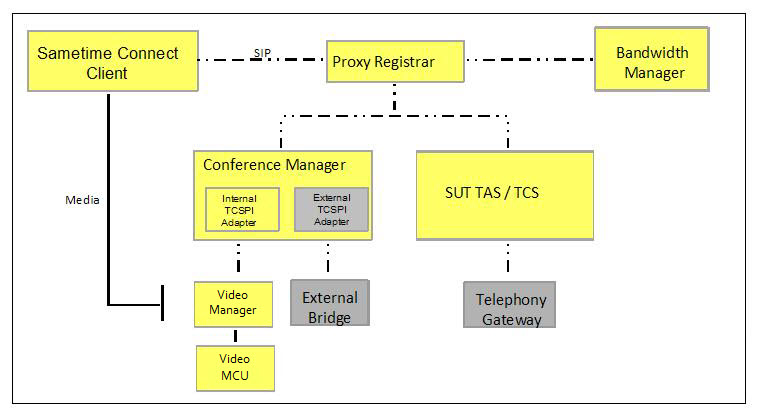Planning for Sametime Bandwidth Manager services
The IBM® Sametime® Bandwidth Manager works with the Sametime Media Manager, controlling bandwidth used in audio and video calls that are handled by the Media Manager.
The Bandwidth Manager requires IBM WebSphere® Application Server 7.0.0.15, so it cannot be installed on the same instance of WebSphere Application Server as other Sametime servers.
The graphic that follows show how the Bandwidth Manager communicates directly with the Sametime SIP Proxy/Registrar, using it to relay bandwidth constraints to clients using audio and video features. If the deployment additionally includes Sametime Unified Telephony, that application shares the same SIP Proxy/Registrar to ensure that it can access bandwidth constraints as well.

In a large-scale deployment, you can install multiple Bandwidth Managers and cluster them using WebSphere Application Server Network Deployment. A Bandwidth Manager cluster requires a dedicated deployment manager (unlike some other Sametime components, the Bandwidth Manager does not use the Sametime System Console as its deployment manager) and can include up to two instances of the Bandwidth Manager application. No other SIP applications can reside in the same cell. In a horizontal cluster, deploy one primary node and one secondary node; in a vertical cluster, deploy both instances on the same node.
Prerequisite components
- DB2®
The Bandwidth Manager requires DB2 UDB 9.5 or later, with the latest fix packs applied (use the same version used by other Sametime components in this release). You can use the same DB2 server that you install for other Sametime components (console, meeting server, gateway server). You will need DB2 instance owner and administrative credentials during bandwidth manager installation.
- LDAP directory
The Bandwidth Manager requires an LDAP directory to which it has read access since it looks up, creates, and modifies both users and groups while applying bandwidth management policies; use the same LDAP server that is used by the rest of the Sametime deployment.
- Sametime Media Manager
The Bandwidth Manager works directly with the Media Manager's SIP Proxy/Registrar (use Sametime 8.5.2 or later because the Bandwidth Manager is not supported in earlier releases). SIP is the only signaling mechanism for describing bandwidth required for a call. The Sametime SIP Proxy/Registrar is configured (force-route) to pass all incoming signals to the Bandwidth Manager, and to pass outgoing signals from the Bandwidth Manager go to the intended destination.